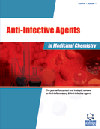- Home
- A-Z Publications
- Anti-Infective Agents in Medicinal Chemistry (Formerly Current Medicinal Chemistry - Anti-Infective Agents)
- Previous Issues
- Volume 6, Issue 3, 2007
Anti-Infective Agents in Medicinal Chemistry (Formerly Current Medicinal Chemistry - Anti-Infective Agents) - Volume 6, Issue 3, 2007
Volume 6, Issue 3, 2007
-
-
Dendrimers and Dendritic Polymers as Anti-infective Agents: New Antimicrobial Strategies for Therapeutic Drugs
More LessAuthors: J. Rojo and R. DelgadoNearly 3 decades ago, a dendritic structure was stepwise synthesized for the first time as a new type of molecules with promising applications. During years a huge effort has been devoted to implement the synthetic skills concerning the synthesis of these molecules and especially, new methods for purification and characterization of these compounds that are in the nanoscale range. The chemical manipulation of the su Read More
-
-
-
Antibacterial Peptides - A Bright Future or a False Hope
More LessAuthors: R. Bucki, I. Levental and P.A. JanmeyThe increasing number of antibiotic resistant bacterial strains presents an emerging world health problem that demands continued effort to develop new antibacterial compounds. Endogenous antibacterial peptides (ABPs) that are constitutively and/or inducibly produced in tissues exposed to external surroundings represent new candidates for development of such compounds. Most ABPs target bacterial membran Read More
-
-
-
Novel Antiinflammatory and Antiinfective Agents
More LessAuthors: Patrick Garidel, Jorg Andra, Jorg Howe, Thomas Gutsmann and Klaus BrandenburgDespite the availability of antibiotics, infectious diseases become an even increasing threatening for human health, in particular due to resistance development, for example in animal husbandry. Furthermore, the sepsis shock syndrome, which in many cases is a result of the fact that antibiotics may kill bacteria, but do not inactivate bacterial virulence factors such as endotoxins (lipopolysaccharides), is worldwide of increasing im Read More
-
-
-
The Echinocandins: Total and Semi-Synthetic Approaches in Antifungal Drug Discovery
More LessThe echinocandins are a new class of antifungal lipopeptides for the treatment of serious nosocomial mycoses. The three currently approved drugs, caspofungin, micafungin, and anidulafungin, were each discovered through the synthetic modification of echinocandin natural products obtained from fermentation. This review is intended for the medicinal chemist who is actively pursuing or has a general interest in the s Read More
-
-
-
Pharmacology of Current and Investigational Human Immunodeficiency virus (HIV) Nucleoside/Nucleotide Reverse Transcriptase Inhibitors in Adults
More LessAuthors: Laura Waters and Marta BoffitoSince the mid-1980s, the nucleoside reverse transcriptase inhibitors (NRTIs) have established their position as valuable antiretroviral (ARV) agents in the treatment of human immunodeficiency virus (HIV) infection. Today, NRTIs still constitute the “backbone” of highly active ARV therapy regimens. The combination of different ARV classes has enabled the goal of successful suppression of HIV replication to be achieved in most HIV in Read More
-
Most Read This Month
Article
content/journals/aiamc
Journal
10
5
false
en


